Q&A – Ask Neil: December 21, 2023
(Please read these instructions carefully.)
Before you post your question, please look at recent issues to see if someone else has already asked it. You might find your answer there.
How to submit your question…
(Note: You may need to allow a pop-up window to come up in order to get the link for sending your photo(s). If you have already submitted your question and didn’t see the pop-up window, please click here.)
• Click the link provided below to post your question. After you submit your question, a new window will pop up giving you the address to which you can e-mail a SHARP, HIGH-RESOLUTION PHOTO to accompany your question. Please DO NOT SEND THUMBNAIL PHOTOS in case I need to zoom in to see things.
• Click here to post your question.
• Please ONLY POST YOUR QUESTION ONE TIME. We can only accept a set number of questions each week, and when we get duplicates it costs other people their chances.
• One question per reader, please.
• Please use this only for posting questions – not for standard emails.
• Watch for your answer in the following week’s e-gardens.
• I choose those of greatest general interest. For example, plant IDs seldom make the cut.
• I must have your first name or initials.
• I must have your city or county. (Texas is a very large state.)
QUESTION 1
HOW DO I KEEP AN AVOCADO TREE ALIVE?
Question: How do I keep an avocado tree alive? It gets approximately 4 ft. tall and then dies out. I can’t figure out if I’m watering it too much or not enough or if there might be another reason that it won’t keep growing. I sprout the seed and then plant. Karen R., McKinney.
Answer: Several facts we need to remember. First, avocado trees are just that. They grow to become trees. Just like other fruit-producing trees, they need full sun to do their best. But they also are tropical. They won’t tolerate any temperatures below freezing. That’s why almost all Texans must grow them in pots and move them into a greenhouse or very bright sunroom for them to make it through the winter. And the pot will gradually have to be larger and larger as the tree grows. It’s quite possible that you will end up needing a 36-, 42- or even 48-inch pot. If they’re grown in smaller pots, they easily become rootbound and can dry out before you know it. You also need to be able to run water completely through the pot so that you can leach out any accumulations of mineral salts periodically. You didn’t attach a photo so it’s hard for me to get much closer to a firm solution.
QUESTION 2
A MERRY CHRISTMAS PHOTO TO SHARE
Question: We enjoyed your radio program when we lived here (in Texas) 30 years ago. Then we moved to California (where everything grows), but now we’re glad to be back in Texas. Marylu L., Midlothian.
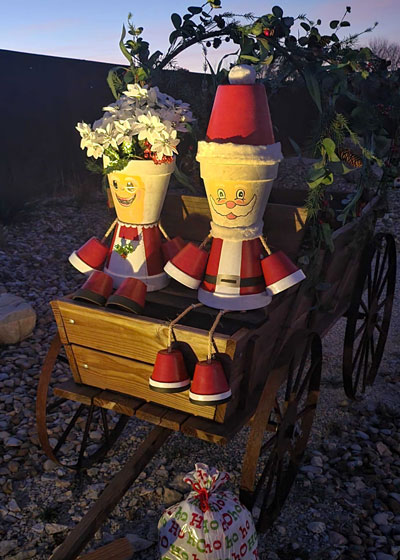
Answer: We’re glad to have you here. Our state hasn’t changed much, has it! Just like you left it.
(I hope you’ll join me on one of my radio programs. I’m still on the air after all these years!)
QUESTION 3
WHAT IS HAPPENING TO OUR ONE OAK?
Question: Pictured is my oak from the front yard. It’s looking brown, like it’s dying. Also pictured is the same kind of oak from the backyard. It looks healthy. What is wrong with the one in the front yard? John E., Oak Point.
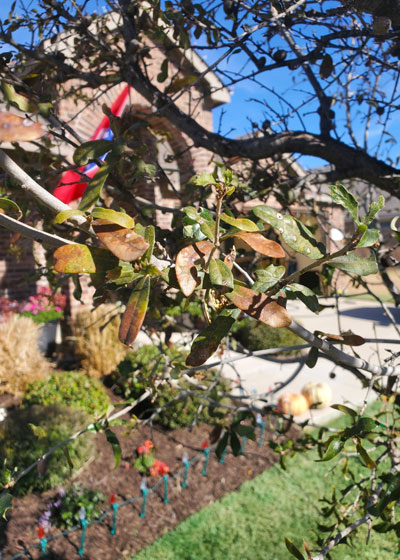
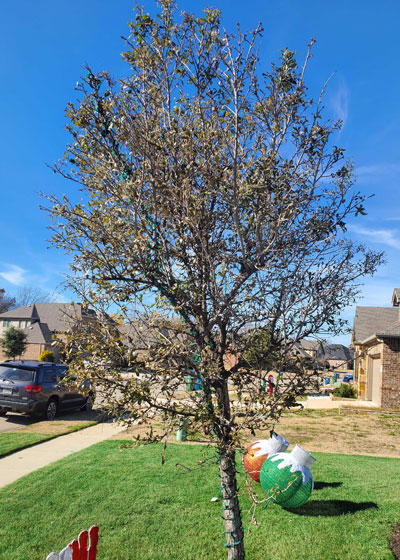
Answer: These are live oaks. The one in the front yard looks like it may possibly have had some galls in it, but I can’t see well enough to tell for sure. It’s a relatively new tree and I normally would have suggested the possibility that it might have gotten too dry, but then I saw your lovely lawn. It looks like its branches and twigs have been fairly healthy. I would examine the bark closely for signs of sunscald on the southwest or west sides. I also would check the root flare to be sure it didn’t sink into the ground after planting. Sadly, it’s not plumb and it never will be. If I moved into your house, the first thing I would do is dig and reset it vertically this winter. It will look like a crooked picture frame forever, but perhaps I’m just obsessive that way. For what it’s worth, the backyard tree has challenges with its leaves, too. They’re primarily cosmetic. If you keep it watered properly through the winter the new growth in the spring should be just fine.
QUESTION 4
WHAT IS WRONG WITH MY BERRY BUSHES?
Question: We have some berry bushes (and some non-berrying) that start to turn brown. Then, in about 2 months the leaves disappear. That creates holes in the bush and 6 months later the bush is nothing but branches. What is going on? So worried. Christine L., Arlington.
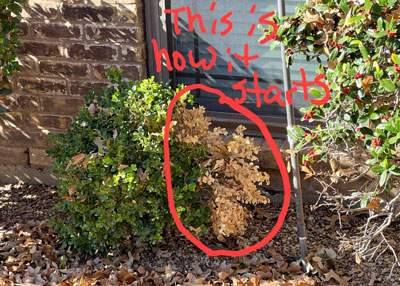
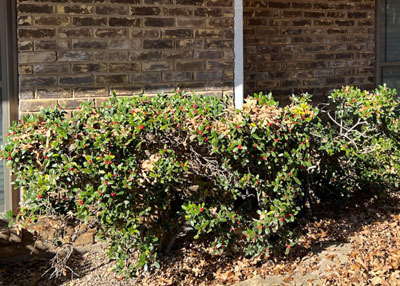
Answer: I wondered what plants you were calling “berry bushes” when I saw your question. The plant with the red circle must be in your “non” category. That’s a Japanese boxwood. The other shrubs (with berries) are hollies, probably dwarf Burford hollies. It’s important to note that these two types of shrubs are totally unrelated to one another. That’s just as a goldfish is unrelated to a Golden Retriever. No insect or disease is going to attack both of those diverse species of plants. In fact, neither of them has very many known problems at all. These plants got too dry last summer. Sadly, I’ve seen thousands of other hollies and boxwoods that suffered the same or worse fates. We’ve had two years in a row with very bad droughts toward the ends of the summers. All you can do to help these plants is trim out the dead wood, fertilize the plants in early March with a high-nitrogen lawn food to stimulate new growth in the spring, and keep them thoroughly watered all season long. Be careful that your fertilizer does not contain a weedkiller component.
QUESTION 5
SHOULD I SELECT RED OAKS IN THE FALL TO SEE HOW GOOD THEIR FALL COLOR WILL BE?
Question: Years ago I was advised to buy red oaks in the fall so I could select trees with the brightest colors. Do they vary enough to make that relevant? I planted two 20 years ago. They’re now landmark trees, just not very “red.” I’m planning on planting more. Jim T., Highland Park.
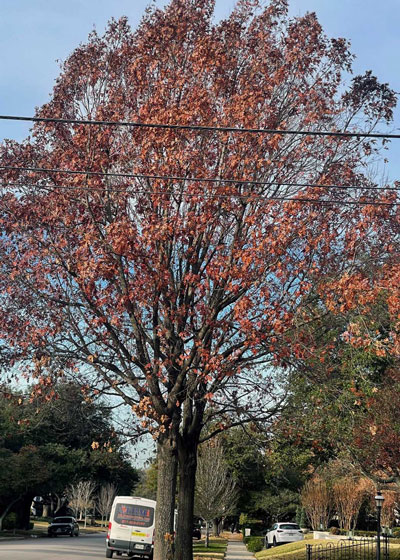
Answer: It’s been my career-long personal observation that fall color on red oaks depends more on any given season’s weather conditions than it does on the genetics of each tree. If we get some rains in September and then warm, dry conditions in mid-fall, then near-freezes, they seem to have more brilliant colors. I live in a forest made up of pecans and Shumard red oaks. We have probably 50 mature red oaks on our 11 acres, and they really do vary from fall to fall. But the good news is that for 51 weeks out of every year, they’re spectacular landscape plants. Fall color isn’t a huge factor in my mind.
QUESTION 6
CAN HYDROGEN PEROXIDE BE USED TO PREVENT ROOT ROT?
Question: I have heard that watering plants with hydrogen peroxide diluted 1:4 with water helps prevent root rot. I tried it with a bed of daisies and at least it did not seem to harm them. Is there any other treatment that is effective? John B., Abilene.
Answer: If you stumble around on the Internet with that topic, you’re going to find lots of discussions. But little information comes out of universities. Most of it more accurately fits into the categories of “home remedies” and “suppositions.” My own personal remedy is to use a well-draining planting soil comprised of sphagnum peat, finely ground pine bark mulch, compost, well-rotted manure, and expanded shale. I rototill that to a depth of 10 to 12 inches. It ends up being almost like potting soil. Root rot funguses usually live in stagnant soils where there is limited pore space for air (oxygen). I did see one home gardener report saying they had damaged their plants by using too much of the hydrogen peroxide. Not that it matters much, but I have never felt compelled to use it.
